Welcome to Goonhammer ‘02! We’re taking a look back to 20 years ago and some of the key releases of 2002. Today we’re talking about the release of Codex: Chaos Space Marines and the impact it had on the 40k universe.
I cannot tell you how excited I was to review this book. I didn’t even remember that it released in 2002, but when we were planning this “Goonhammer ‘02” thing I went back and looked at the Codex releases for 2002 and saw that the list was Dark Angels, this book, and Necrons and I decided then and there that yes, we’d be doing the ‘02 stunt.
Why was I excited for this, you ask? Because this book – Codex: Chaos Space Marines (3.5), the second codex released for the faction during 3rd edition – is the best book Chaos has ever had and probably the best codex GW ever released. There isn’t a Chaos player around who played during the era who would disagree with that statement, and for good reason: This is the book that introduced us to rules for the Chaos Legions, and at the same time it was tremendously powerful, spawning dozens of viable lists (some more miserable than others).
So join me today as I dive into this book, its contents, and how it reshaped the future of the faction.
Wait, 3.5 Edition?
Let’s start with that designation. See, third edition Warhammer 40,000 was a massive departure from 2nd. Whereas 2nd edition still had a number of RPG-like elements carried over from rogue trader such as individual damage charts for each vehicle, the use of wonky dice for damage such as d10s and d12s, and all manner of bespoke templates, 3rd edition sought to streamline the game substantially, focusing less on characters and more on movement and positioning. 3rd edition introduced uniform movement values for unit types, new systems for AP and damage, an entirely new system for melee combat more like that of Warhammer Fantasy battles, and it did away with the Psychic phase entirely. The net result was a game where armies doubled in size (marines literally went from 30 points to 15), but games took half the time.
Along with this streamlined approach came a very minimalist take on Codexes. The 3rd edition core rulebook included new profiles and army rules for every army in the game in the same way Indexes did for 8th edition, and 3rd edition Codexes were meant to act as rule supplements first and foremost. Codex: Chaos Space Marines (3rd) was among the first of these new books, released in February 1999, less than a year after the edition’s launch. The book clocked in at a brisk 47 pages, with more than half of those (25) making up the rules section and another dozen making up the hobby/modeling parts. There wasn’t much in the book in the way of fluff.

This book worked well enough for Chaos Space Marines players for the first couple years of 3rd edition but then in Games Workshop began publishing the Index Astartes series in White Dwarf. Starting in January 2001 with an article on the Codex Astartes and following that with the Dark Angels, the first legion, and running through 2005, White Dwarf would publish monthly articles on the Space Marine legions. Each of these articles would flesh out the backstory of the legion, offering new insight and lore around their founding and giving us new details we’d never before heard on these chapters. Even more importantly, following the Dark Angels was the article on the III Legion, the Emperor’s Children. You have to remember that this was well before Black Library would give us Horus Heresy novels, and so for the first time, 40k fans learned about the genetic flaw that almost wiped out the III legion, Fulgrim’s desire for perfection, the cleansing of the Laer, and Eidolon. The article then finished off by giving us Chapter Approved rules for playing the Emperor’s Children Chaos Space Marines Legion on the table.
This was amazing – for the first time, Chaos Space Marine players had special rules for their legion, same as the big loyalist chapters. And they were pretty rad, giving us rules for noise marine terminators again, sonic dreadnoughts and bikers, and letting regular squads take sonic weapons. Shortly afterward they’d release an article doing the same for Iron Warriors, and the same for every legion, giving us rules for the nine traitor legions and rules for the mission loyalists (while Salamanders got rules in Codex: Armageddon, Imperial Fists, Raven Guard, and White Scars first got chapter rules here).
Which brings us to 2002. By the summer of 2002, Games Workshop had covered up through the Word Bearers legion in Index Astartes, and had released a brand new plastic chaos space marines kit as well as new metal upgrade kits for it to let players model many chapters, most notably Emperor’s Children, Death Guard, Night Lords, Iron Warriors, and Thousand Sons. And in October 2002, they released their second Codex: Chaos Space Marines of 3rd edition, a much thicker tome that collected these rules for every chaos legion into a single book.
So yeah, 3.5 edition.
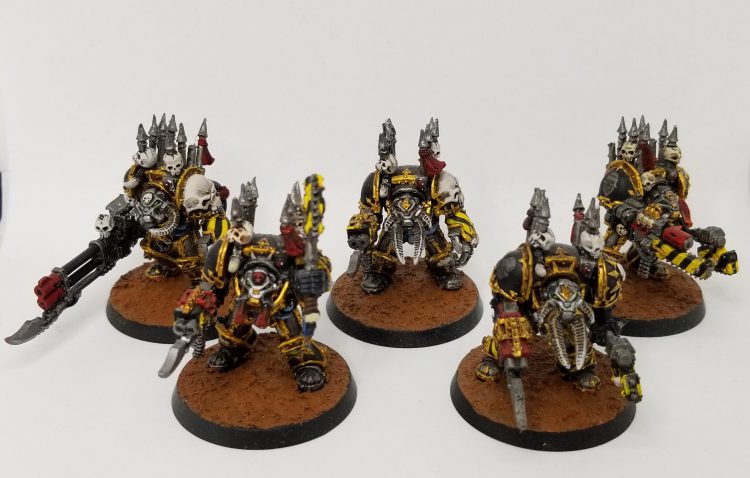
The Lore
If the early 3rd edition codexes were little more than rules pamphlets, the later wave of 3rd edition codexes, including the Chaos Space Marines and Imperial Guard second releases, were a bit more robust, doubling the size of the prior books and adding actual fluff back in. That said, it’s clear that there’s still a lot being left out, and the notion is likely that you’ll read the rest in the Index Astartes series. The book opens up with a two-page spread on the Horus Heresy, giving us the major beats starting with the Primarchs and the virus bombing of Istvaan III, followed by the demise of Horus and the Emperor. Then we have a two-page spread about the Warp, detailing the geographies of the Eye of Terror and the Maelstrom. Finally, the third two-page spread gives us the history of the post-Heresy conflicts between Chaos and the Imperium, such as the first war for Armageddon and the Black Crusades of Abaddon. These have been fleshed out in much more detail here, including a whole section on the Gothic Wars to coincide with the work that had been done on the recently-released Battlefleet Gothic game.
After that, it’s on to rules, though once you get through the army list you get to THE BOOKS OF CHAOS, a section that has a bit of backstory and rules for each of the Chaos Space Marine legions.
On the whole there isn’t a ton of new lore here – you can get a longer version of the Gothic War backstory in Battlefleet Gothic, while the then-definitive versions of the legion backstories were in the Index Astartes articles, which would later be published in four collected tomes, the latter two of which are now impossible to find. At this point however, the lore was basically set – unlike in our look at the 2nd edition Codex Chaos where foundations were still being laid and it wasn’t clear what the nature of a primarch was, the Index Astartes articles essentially finalized the current lore that would be fleshed out in the Black Library novels. Breadcrumbs from those articles, such as the cleansing of the Laer or the Iron Warriors’ rivalry with the Imperial Fists, Horus’ corruption, and Angron’s tragic backstory on Nuceria all started in the IA articles and would become major story beats later on.
So while most of that isn’t in this particular book, it had just been written and made available at the time, and with its release we got the legion rules that would later define the traitor legions as they exist today.
No Renegades?
One of the interesting quirks of the 3.5 book is that it continued the 3rd edition book’s move of omitting Huron Blackheart and the Red Corsairs. They’re mentioned in both in fluff, but the rules for them are gone. Huron wouldn’t show up again until the 4th edition book, which is when he finally got a model.
On a related note, Doomrider was also removed from the game at this point. Few people seemed to notice. Nobody liked that guy.
The New Characters
As replacements for the missing characters – and to give us one character for each major chaos god, two new characters were added: Lucius the Eternal of the Emperor’s Children and Typhus, the Herald of Nurgle. Both would eventually get metal models but neither was ready for the release of the new book.
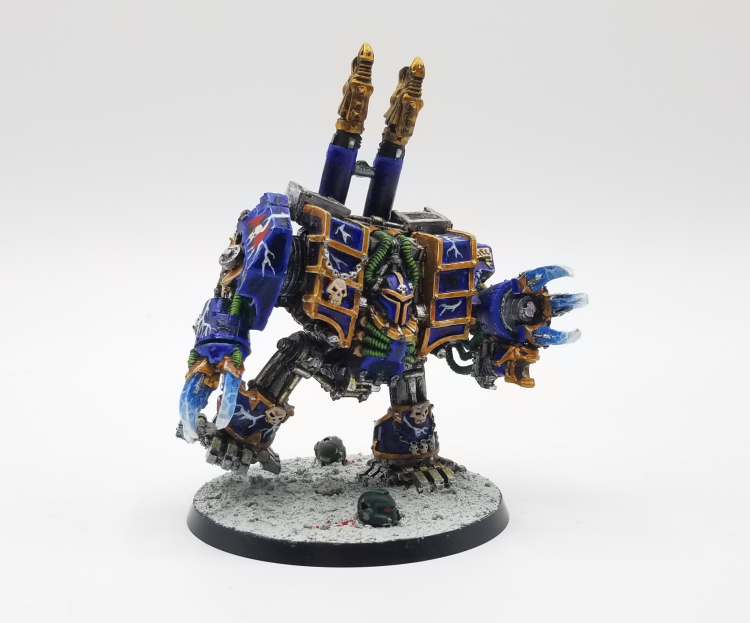
The Rules
If anyone has fond memories of the 3.5 Chaos Marines book, this is why. This is Andy Chambers and Pete Haines at the top of their games, writing a book that was packed with options and flavor while also being mechanically powerful and offering multiple ways to build competitive armies. The ’99 Codex Chaos was as thin on rules as it was fluff and this new book is absolutely packed with rules and different ways to build and customize your armies. They’d pulled off the same feat already with the 3rd edition Codex: Tyranids, and they’d do the same with the second third edition release of Codex: Imperial Guard.
Chaos Space Marines are presented here as grizzled veterans who have devoted themselves in varying degrees to the dark gods and now work alongside daemons. While the 4th edition Chaos Marines book would split Chaos Marines and Daemons into separate armies five years later, at this point lesser and greater daemons were still very much a part of the army, though any units you took apart from Nurglings and Daemon Princes would have to be summoned into battle rather than being deployed to the table normally.
Marks of Chaos
Marks of Chaos return here, one of the ongoing staples of the Chaos Space Marines that would endure through 7th edition. Here marks of Chaos will cost you points – typically 1-5 per model in squads or 10 for your characters. Marks have specific benefits and drawbacks and some can’t be given to certain units, i.e. a Raptor can’t have the mark of Nurgle, and for the first time your units can only ever have a single mark of Chaos.
- The Mark of Khorne gives you the Blood Frenzy rule, which gives the model +1 attack, Fearless, and forces the model to charge if there’s an enemy within range in the Assault phase. Oh and also every turn there’s a chance (1-2 on a D6) they’ll just advance D6″ toward the nearest enemy instead of moving normally. Given how bad shooting was for a lot of these units, this is actually a huge benefit, since it meant your units might move an extra D6″ on top of their move and still charge afterward. Blood Angels armies used to use this trick all the time with Rhinos and now your World Eaters can too!
- The Mark of Nurgle gives you Fearless, Daemonic Resilience (+1 Toughness), and True Grit, letting you shoot your bolter as if it were a pistol in melee (you get +1 attack, basically). The downside is that units with the Mark of Nurgle can’t carry lascannons, autocannons, missile launchers, or heavy bolters. There isn’t any particular reason for this, just that they like to use bolters.
- The Mark of Slaanesh makes you Fearless and gives you the Warp Scream ability, which basically reduced enemy Initiative by 1 in melee. Given that Initiative is how you determine who fights first in 3rd edition, this ability was insanely good. Additionally, models with the Mark of Slaanesh can replace some of their weapons with sonic weapons, letting you create noise marine terminators, sonic dreadnoughts, and sonic predators, which kicks ass.
- The Mark of Tzeentch is the odd one out here. If it goes on a Character, Chosen, or possessed, it gives them the Sorcerer ability and they auto-pass psychic tests (pretty great), but you have to buy powers for the models in the unit individually (you used to pay points for different powers). Chaos marine units with the mark become Rubrics, gaining the fearless, slow and purposeful (always count as stationary, move as if in difficult, no +1 attack on the charge, fight last in combat), and daemonic essence (+1 wound) rules. Models with the Mark of Tzeentch can’t take any veteran skills.
- The Mark of Chaos Undivided, first introduced in the third edition book, is more like a default, giving a character/unit the ability to re-roll failed Morale checks. Because your units don’t have “And They Shall Know No Fear” to prevent dying after losing a combat, this is super important to have if you aren’t fearless.
There’s a ton going on here but generally the idea is that adding a mark has significant impacts on the way units behave. As a consequence, there are no separate unit entries in the book for Berzerkers, Noise Marines, Plague Marines, or Rubrics – instead you create these by giving the relevant mark to a unit and kitting them out accordingly.

Veteran Skills
Chaos Space Marines are veterans of the long war and have been fighting for millennia. And over that time they’ve accrued a very specific set of skills. A unit can have any number of veteran skills unless it has a mark, in which case it can only take one. There are 8 veteran skills to pick from and they vary in cost (1-3 points per model for squads), but the net here is that they let you tailor the squad to its purpose. Options include Furious Charge, to get +1 Initiative/Strength on the charge, Tank Hunters to get +1 to your armor penetration rolls, Infiltrate to forward deploy your units before the game, and Skilled Riders to re-roll difficult terrain tests. It was typically worth it to take these.
Daemonic Gifts
If the thought of hardened veteran legions flexing skills isn’t enough for you, there are also daemonic gifts, which represent the various mutations and powers bestowed upon your units by the dark gods. There are limits to who can take these, however – Chaos Lords/Sorcerer Lords can take as many as they like, but if they take more than 50 points of Daemonic Gifts, they become a Daemon Prince instead and must be modeled accordingly. As part of this, one of the gifts you can take is Daemonic Stature, which gives the character +1 Strength and Toughness and turns you into a Monstrous Creature, but locks you out of taking steeds or riding in transports and reduces your BS to 3 while improving your WS to 6. Also, you have to go on a 40mm base.
When it comes to the rank-and-file, you can also take Daemonic abilities on Possessed, who no longer needed to roll for their ability but could now buy a single upgrade from a list of 5 options that included Flight, and Talons. Flying possessed are basically the replacement some legions will get for Raptors.
Otherwise Daemonic Gifts show up on on units but aren’t really purchased for them – Obliterators have both Daemonic Aura and Daemon Armor, giving them a 2+ save/5+ invulnerable, for example, while Raptors have Daemonic Flight and Daemonic Visage.
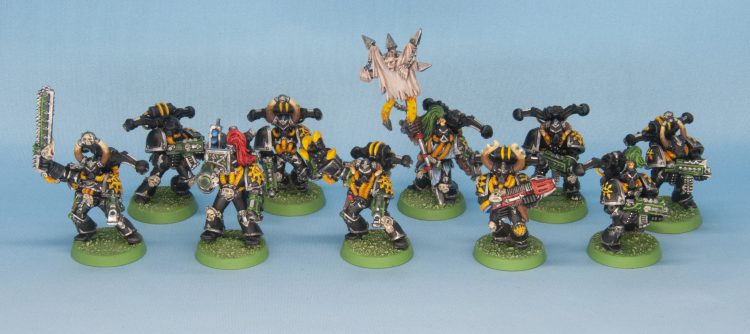
The Traitor Legions
The biggest thing here is the creation of rules for the Traitor Legions. Most of these had already been initially published in White Dwarf, though rules for the Alpha Legion – the XX chapter – were completely new here. Each of the non-devoted Legions gets a full page, while the legions dedicated to the four Chaos Powers have 4 pages each, in sections called “The Book of <GOD>.”
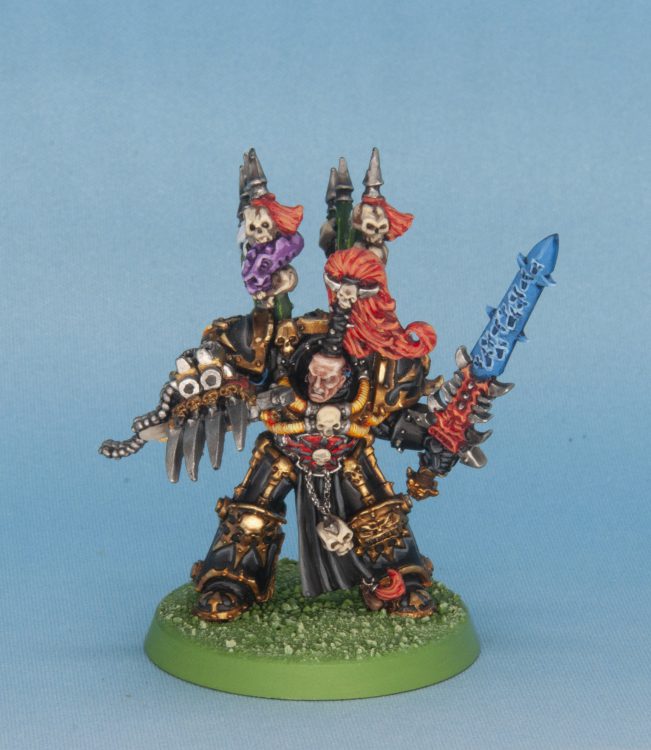
The Black Legion
The Black Legion actually kind of get the shaft here – they’re presented as being essentially “the basis for Codex: Chaos Space Marines,” and as such don’t really have any special rules save for the ability to bring Abaddon the Despoiler in games of 2,000+ points. That said, Abaddon is very, very good – he has all four marks of Chaos and his sword Drach’nyen makes one attack per turn that can’t be re-rolled but ignores armor saves and automatically kills the target outright if it wounds.
Abaddon’s all well and good but it kind of stinks to see Black Legion get the Chaos Ultramarines treatment, something the Ultramarine would eventually shrug off as they got special units to represent the veterans of the Tyrannic War. the Black Legion wouldn’t get their due officially until 6th edition. They did have some upside, however – they weren’t limited in their marks like most of the other legions, and could freely mix units of Noise Marines and Berzerkers and the like, which did matter.
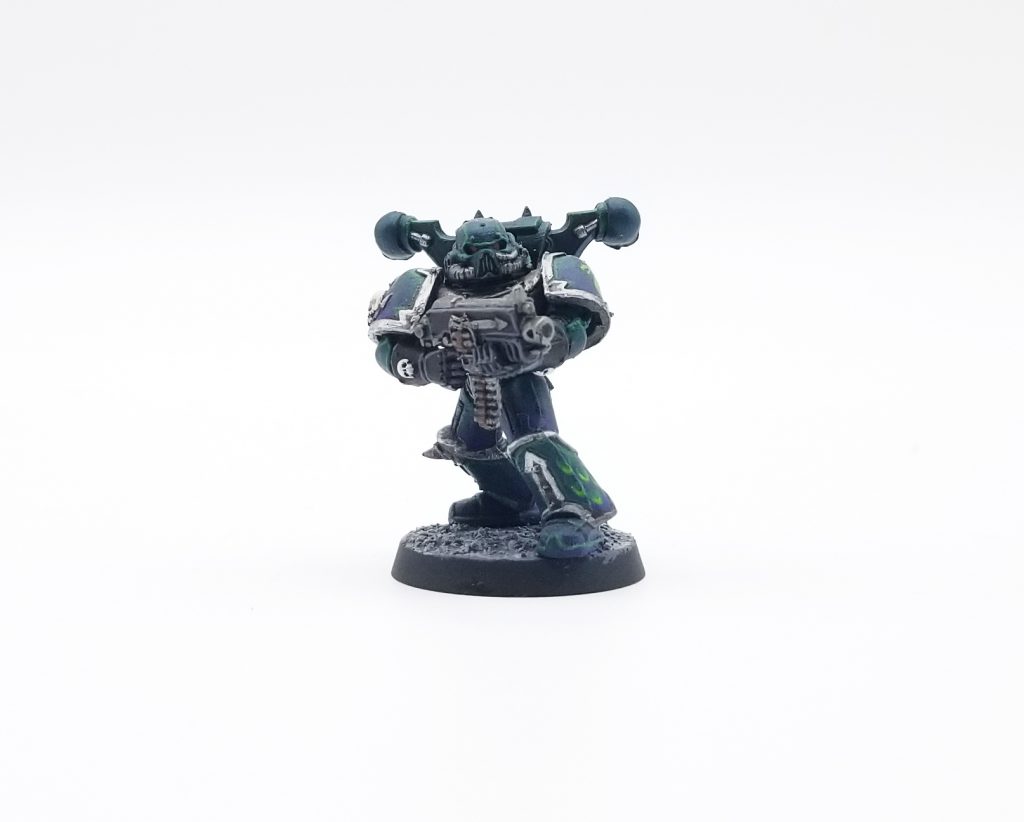
Alpha Legion
The Alpha Legion got their first set of rules, announcing them as the guerilla fighters of the Chaos legions. They could only bear the Mark of Chaos Undivided but they got the ability to buy the Infiltration skill at a discount on their units and without it taking one of their skill slots. They’re the only army that get access to Chaos Cultists, a unit that was missing from the 3rd edition codex but was brought back here (they had metal models released in 1998). In addition to having Cultists, they could give each unit of Cultists veteran skills – Infiltrate and one of Move Through Cover, Furious Charge, or Siege Specialists, depending on the role you wanted them to play. As the Alpha Legion operated in Real Space they were often too far out to rely on Daemons and so as a result only Alpha Legion Cultists could carry the icons necessary to summon Daemons.
This gave the Alpha Legion a much different playstyle, often incorporating multiple units of cheap Cultists to trade with opponents, since even a garbage 6-point cultists suddenly becomes a threat when it charges in and fights at the same time as marines with S4 weapons.

Iron Warriors
The Iron Warriors are siege specialists, and their rules reflect that. They can only have the Mark of Chaos Undivided (a change from their Index Rules, which allowed them to take a unit of Berzerkers), and can’t field Daemons, though they could still take Daemon Princes and Possessed (with the latter being more like cybernetic monsters). In exchange, Iron Warriors all got the Siege Specialist skill for free and without using a slot (this was whatever), plus they could give up two of their Fast Attack slots to get an extra Heavy Support slot in their Detachments, letting them cap out at 4 Heavy Support and 1 Fast Attack.
This was huge, in part because Iron Warriors both got to take more than 1 unit of Obliterators (the only legion who could do so), and because they got access to Basilisks and Vindicators from the Imperial armories, which again, they were the only legion who could. Vindicators would later become available to all of the legions but at this point it was just Iron Warriors. Also they could take Servo Arms on their characters.
This made the Iron Warriors a punishing army to play against, as they’d typically either run 6-9 Obliterators, or a host of Basilisks and Defilers to shoot indirectly at you. Or Vindicators. The point was, they’d shoot you off the table and had the firepower to do it like no other legion.
Kevin: And boy was it FUN to field them. 3rd Edition was the era of the Rhino Rush, when you could have legions of pissed off marines drive a full distance in their metal boxes, disembark, and then charge right into the enemy. Combine that with some absolutely brutal shooting using templates and you had a very strong army.

Night Lords
The Night Lords are the masters of terror, sowing fear among the enemy with their devastating raids. They don’t worship the Chaos gods and so can’t take marks or have daemons, except for Furies, which are often enslaved by Raptor Cults. They can still take Daemon Princes and Possessed, though. They all get the Night Vision veteran skill as a bonus, which can be useful in Dawn Raid or Night Fight missions, and in an interesting reversal from Iron Warriors, can give up two Heavy Support Slots to take an extra Fast Attack choice, going 4 FA/1 HS. This was helpful given that they were the only legion that could take more than 1 unit of Raptors. Finally they got an additional skill, Stealth Adept, which would give units +1 to their cover save.
My boys probably got done the dirtiest by the new rules but even they had a lot to recommend them. Raptors and Bikes were very strong units and the former had the ability to Hit and Run, falling back after a round of combat in order to charge in again the following turn. They’d go heavy on Raptors and Bikes over shootier options.
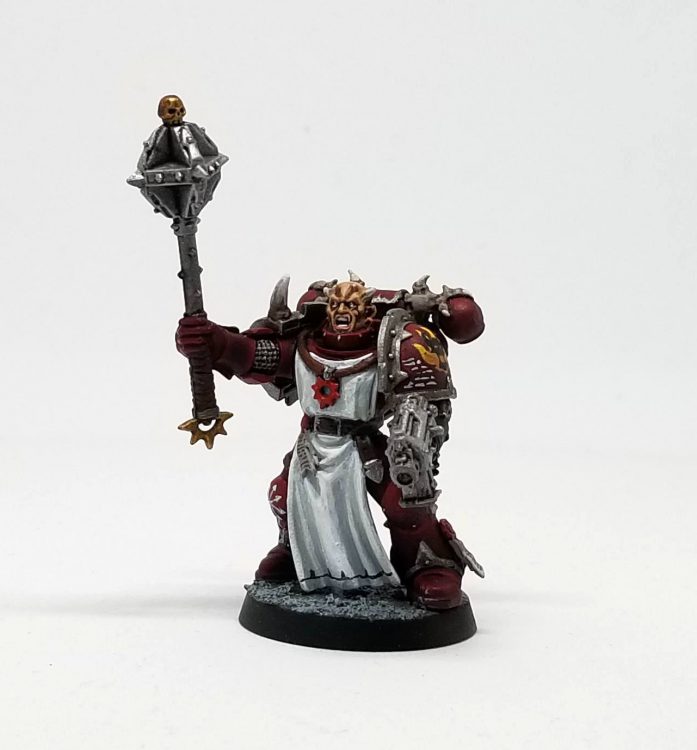
Word Bearers
The original worshippers of Chaos, the Word Bearers can only take the Mark of Chaos Undivided, but can use any type of Daemon, and they have the ability to designate one Lord or Lieutenant to be a Dark Apostle, giving it an Accursed Crozius and the Demagogue ability. These upgrades came to 60 points total but would give your character an Icon, a 4+ invulnerable save, and make friendly non-daemon units within 6″ automatically pass their morale checks.
Whereas the Iron Warriors and Night Lords gave up fast attack and heavy support to gain the other, Word Bearers relied on troops, and could give up one each of their Elites, Fast Attack, and Heavy Support choices to take an additional three Troops choices, taking up to nine in a game. This was helpful for taking large numbers of daemons.
Word Bearers were quite a terror on the late third edition battlefields. They’d typically employ units of bikes with icons to zoom across the table and summon units of daemons in, dropping them right in an opponent’s face.
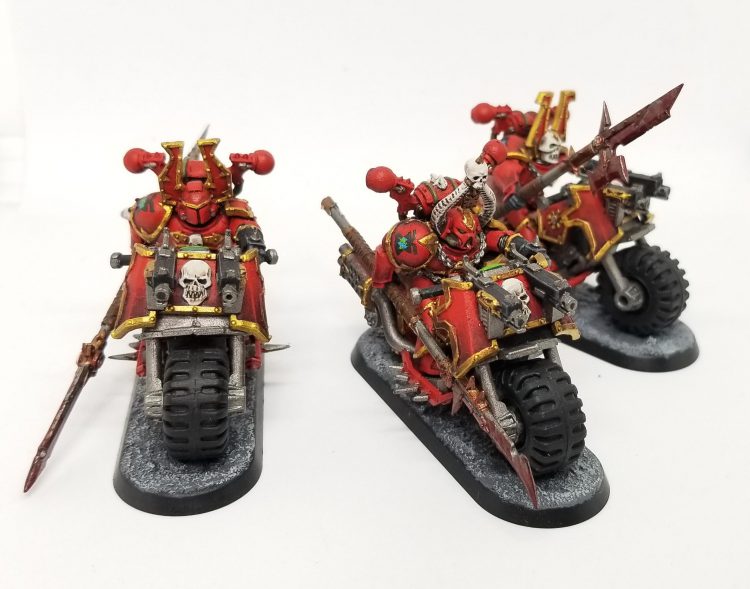
The Book of Khorne: World Eaters
World Eaters got their own section here, which included some custom wargear, army rules, and rules for Kharn the Betrayer. If you’re running World Eaters all of your units have to have the mark of Khorne, and your Daemons have to be Khornate, but your marines can upgrade their weapons to khornate chainaxes for 1 point (these are like Choppas, in that they limit you to a 4+ save). One of the cool bonuses here is that units of 8 or 16 models (multiples of Khorne’s number) are considered to be Favored and can upgrade one model to a champion for free, and they also get +1 to their summoning rolls. World Eaters armies can’t take Raptors or Havocs, with the former being a weird omission, but would just pile into rhinos and use those to get into melee.
Kharn’s here and he’s kind of crummy, actually. He still hits anyone nearby on a miss but he hits on a 2+ regardless of the opponent’s WS but otherwise is just a S4 power weapon. It’s pretty boring and you can build much better close combat monsters. He doesn’t even have an invulnerable save in this iteration.

The Book of Nurgle: Death Guard
In similar fashion, the Death Guard get their own section, with wargear/gifts, special rules, and a character, Typhus. They can only take the mark of Nurgle and Nurgle daemons, and they get free champions for doing multiples of 7. In addition, your Death Guard forces can’t include Raptors or Bikes (though you could take Havocs, they just couldn’t have heavy weapons, so you’d be taking 4 meltas instead), and only two units in Rhinos could be Troops – the rest would have to be Fast Attack.
The new kid on the block here is Typhus, a Sorcerer in Terminator Armor who can only show up in games of 1,500+ points. He’s got a pretty solid statline and the ability to cast psychic powers, plus the Destroyer Hive, which gives him grenades and a better version of Nurgle’s Rot.

The Book of Slaanesh: Emperor’s Children
The Emperor’s Children were the first legion to get extra rules through Index Astartes (the Dark Angels already had a codex), and they also had what were arguably the most powerful rules of the bunch. An Emperor’s Children army had to have the mark of Slaanesh and got a free champion for having 6/12 models in a unit. They couldn’t take Raptors but could take everything else and their big benefit was being able to put sonic weapons on units and vehicles – and those options were pretty good. The Blastmaster had two modes and both were pretty good while the Sonic Blaster was a straight upgrade over the boltgun. On top of that, they had some choice wargear, including Combat Drugs to improve their stats for an Assault phase.
The new Emperor’s Children character is Lucius the Eternal, a nasty close combat opponent for taking on enemy characters. He’s alright but again you can do better building your own.
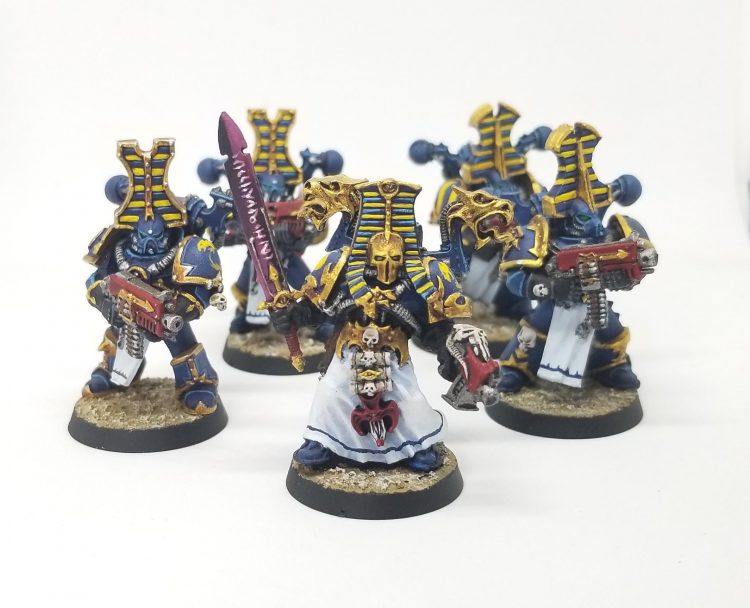
The Book of Tzeentch: Thousand Sons
Finally we have the Thousand Sons, who must take the mark of Tzeentch and those daemons, and whose favored number is 9. While your regular marines and terminators become Rubrics, your characters and champions become sorcerers. In many ways, this is intended to make up for the lack of heavy weapons as Havocs cannot take the mark of tzeentch, nor can the squads upgrade their weapons. Instead, your characters and champions can take the Bolt of Change power, a 24″ S8 AP2 Assault 1 shot that acts pretty much the same way a Lascannon would. You also get a variety of minor powers to take here as well, giving you the ability to roll for one of 5 minor powers for 10 points. They’re very different from other Chaos armies but have their own cool stuff going on, in part because they have a bunch of 2-wound infantry.
Ahriman returns here as the Thousand Sons’ delegate and he’s still an absolute monster, knowing all the Tzeentch psychic powers plus a pair of minor ones and he has the ability to fire off the same power multiple times per turn with his staff, potentially just mashing you over and over with Bolts of Change.
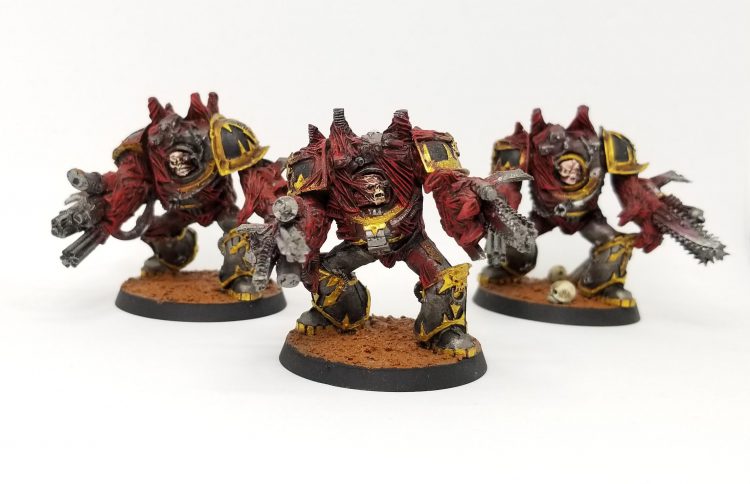
The Units
Throughout 2002 and 2003 Games Workshop would overhaul the Chaos Space Marines range. While we’d gotten some new metal miniatures for Raptors and Obliterators in 1999 following the 3rd edition book release, those were terrible and the only plastic kits for chaos marines were the old monopose box and the plastic Berzerkers kit. In 2002 GW finally released a proper plastic Chaos Space Marines kit, albeit one with only 8 models, but lots of multi-pose options. This kit also worked well with the myriad upgrade kits that Games Workshop put out, allowing them to release new kits for Plague Marines, Thousand Sons, Emperor’s Children, Iron Warriors, and Night Lords that used the new plastic kit as a base. The Rhino and its associated kits also got a new model in 2002, and they released new Chaos bikers as well.
Kevin: This was also the era when you could purchase bits by the pound from Games Workshop, so my Iron Warriors were full of metal servo-arm and pit gang bits.
Although not available at the Codex release, GW would later release new metal Raptors and Obliterators that redefined the look of both units. The former are still my favorite iteration of the unit and the latter gave the unit a much more respectable stature. The Daemon Prince also got a proper metal 40k model within the following year, giving us the now iconic version that the plastic kit tries to replicate (and fails to do so).
There’s a lone new unit in the Codex and that’s the Defiler, another unit that wasn’t available at launch but would get a release within the following year. The Defiler was a large, crab-legged daemon engine with BS4 and a battle cannon that could be fired indirectly. It counted as a monstrous creature in close combat and could fire clear across the table, albeit with a minimum range of 36″ when firing indirectly. That particular defiler model is still the one in use today, though without the ability to fire indirect the unit has much less utility.

The Legacy
Rob: There’s so much great stuff here that would become the foundation for the modern chaos legions from a rules perspective. While the 2nd edition book laid the groundwork for the legions and the lore around the traitor forces, this is the book where the rules would come together and questions like “why don’t the traitor legions have jump packs?” would get more satisfying answers. And there’s so much cool stuff in here, just from a conceptual standpoint – the idea of having your lord turn into a daemon prince as you buy daemonic gifts for them, the way you turn units into cult units by giving them marks and wargear, and the bonuses for specific numbers of models in a unit, all these come together to make something that feels very fluffy while at the same time giving you a ton of options and freedom to build good lists.
The legion rules were also amazing, essentially giving Chaos nine armies to work with instead of just one. This is the book that got me started down the path of making armies for all nine legions, a project I’m still working on today. Although some of the differences were subtle, they still had a major impact on how the lists played and the identity of the legion, and the way those rules came from the legion fluff were just perfect. Before this book (and Index Astartes), Chaos Marines were whatever – yeah, there were legions, but you didn’t really care about which one you ran. After this book that all changed.
I played a ton of games using this book, which held through the end of third edition until the fourth edition book released in 2007. That fourth edition book was a goddamn travesty, one of the worst Codexes GW ever made. It abandoned the legion rules and split daemons into another book, essentially robbing the army of all of its flavor and any ability to build something mechanically unique. I stopped playing 40k when it released, and didn’t pick things back up again until 6th edition, when a new Codex: Chaos Space Marines came out.
Kevin: I’ve played 40k on and off since around the time Dark Millenium dropped for 2nd edition, and the 2002 Codex: Chaos Space Marines book remains my absolute favorite of all time. Better than the 4th edition Ork book, better than most of the stuff in 8th and 9th, the 2002 CSM book felt like the pinnacle of GW rules writing. Flavorful, powerful, unique, it gave us armies and options that had never been seen before (or since). Was it probably a bit much? Yeah. But it was amazing. The idea that the same book could make a flavorful army for any of the factions, or a player’s own concept, and have it be viable and fun was incredibly rewarding. I consider it a masterpiece of rules writing.
The quality of the 2002 codex made the tragedy of the next book even more devastating. Where the 2002 book had flavor and flexibility, the 2007 book was sterile and depressing. Where players could leverage the rules to create an army that matched their intent, the new book shoved them into an ugly little box and expect them to like it. Iron Warriors went right back to being just a different color scheme, and like Rob I quit until I picked up Orks in 4th Edition. And just like with my Iron Warriors, the Ork codex that followed the 4th Edition book was so bad I quit 40k until 8th came out.
Over a decade ago I was volunteering at the NOVA Open and had a chance to chat with Gav Thorpe about his codex. I was polite but told him how disappointing it was and asked him what happened. He was incredibly open and gregarious, and explained that the original plan for Chaos was that the core book would serve as the foundation from which GW would release a litany of chapter-specific supplements. Basically a Chaos equivalent of what Space Marines have now. That would have allowed GW to give each chapter their own unique spin, and expand on the work done in the previous book. That never happened and CSM players were stuck. As he put it, “The road to Chaos is paved with good intentions” and he was even kind enough to sign my copy of his codex. I still have that book, and I remain grateful for his time and his insight.
Next: More Retro Stuff!
That wraps up our review of Codex: Chaos Space Marines (3.5) but we’ve got more retro content coming at you all through the next week, so stay tuned for more! And if you have any questions or feedback, drop us a note in the comments below or email us at contact@goonhammer.com.
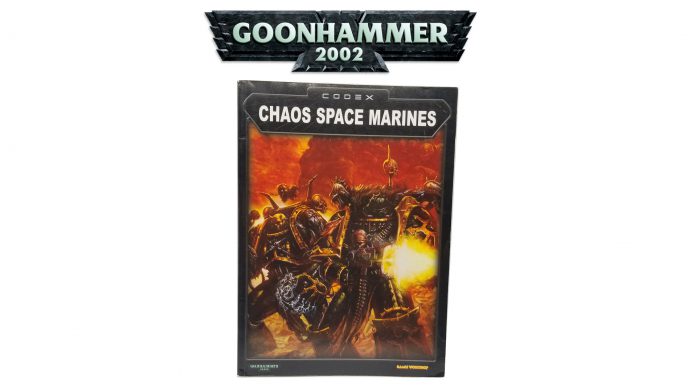


You must be logged in to post a comment.